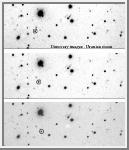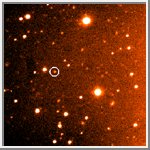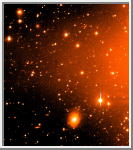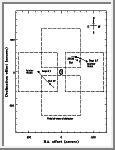|
Uranus has relative feartures in its apperance at visible wavelenghths. Even from Voyager 2 at a distance of 80,000
km there were few features.

| Views of the New Moons of Uranus |
 Discovery image of S/1997 U 2 Discovery image of S/1997 U 2
the brightest picture of the two new moons of Uranus. It name for
know is S/1997 U 2 until they come up with a name for the satilite. Notice the circle motion of the moon
to the background stars. The images were taken roughly one hour apart on September 7, 1997. A faint asteroid in the main belt
may also be observed and identified by its much faster rate of motion.
 Discovery image of S/1997 U 1 Discovery image of S/1997 U 1
This picture is a picture of Uranuses new two moons. It is known as S/1997
U 1 until the International Asronomical Union (also known as LAU ) comes up with a name for the satellite. The glare
from Uranus, which is not pictured
in this picture because it
 avoid saturating the detector,
is visible at the right. avoid saturating the detector,
is visible at the right.
Nicer Color Image of S/1997 U 1
This shows another discovery image of faint new moons of Uranus. It is
designated as S/1997 U 1 until the International Asronomical Union (IAU) comes up with a name for the satellite. The glare
from Uranus, which was placed intentionally off the frame to avoid saturating the detector, is visible at the right. The moon
must be located by looking at the above image. (Credit Brett Gladman, Canadian Institute for Theoretical Astrophysics and
Cornell University)
 Positions of the Moons Relative to Uranus Positions of the Moons Relative to Uranus
This diagram shows the position of the moons relative to Uranus. Uranus
is shown at the center of the picture. The circular orbits of the outermost two previously known moons (Titania
and Oberon) surround the planet, and appear as ellipses because the orbits viewed from Earth are somewhat edge on. The four
search fields for the discovery observations of September 6 and 7 surround the planet, each box shows one shot that was
taken. The fainter moon was discovered almost directly east of the planet. The brighter moon was northwest
at the time it was discoverd. The arcs that the satellites followed after discovery are shown, corresponding to
the preliminary fits to the orbits of the moons, calculated by Brian Marsden of the Minor Planet Center at Harvard University.
| Moon
| #
| Radius
(km)
| Mass
(kg)
| Distance
(km)
| Discoverer
| Date
|
| Cordelia
| VI
| 13
| ?
| 49,750
| Voyager 2
| 1986
|
| Ophelia
| VII
| 16
| ?
| 53,760
| Voyager 2
| 1986
|
| Bianca
| VIII
| 22
| ?
| 59,160
| Voyager 2
| 1986
|
| Cressida
| IX
| 33
| ?
| 61,770
| Voyager 2
| 1986
|
| Desdemona
| X
| 29
| ?
| 62,660
| Voyager 2
| 1986
|
| Juliet
| XI
| 42
| ?
| 64,360
| Voyager 2
| 1986
|
| Portia
| XII
| 55
| ?
| 66,100
| Voyager 2
| 1986
|
| Rosalind
| XIII
| 27
| ?
| 69,930
| Voyager 2
| 1986
|
| Belinda
| XIV
| 34
| ?
| 75,260
| Voyager 2
| 1986
|
| 1986U10
| XVIII
| 40
| ?
| 75,000
| Karkoschka
| 1999
|
| Puck
| XV
| 77
| ?
| 86,010
| Voyager 2
| 1985
|
| Miranda
| V
| 235.8
| 6.33e+19
| 129,780
| G. Kuiper
| 1948
|
| Ariel
| I
| 578.9
| 1.27e+21
| 191,240
| W. Lassell
| 1851
|
| Umbriel
| II
| 584.7
| 1.27e+21
| 265,970
| W. Lassell
| 1851
|
| Titania
| III
| 788.9
| 3.49e+21
| 435,840
| W. Herschel
| 1787
|
| Oberon
| IV
| 761.4
| 3.03e+21
| 582,600
| W. Herschel
| 1787
|
| Caliban
| XVI
| 49
| ?
| 7,169,000
| Gladman
| 1997
|
| Stephano
| XX
| 10
| ?
| 7,948,000
| Gladman
| 1999
|
| Sycorax
| XVII
| 95
| ?
| 12,213,000
| Nicholson
| 1997
|
| Prospero
| XVIII
| 15
| ?
| 16,568,000
| Holman
| 1999
|
| Setebos
| XIX
| 15
| ?
| 17,681,000
| Kavelaars
| 1999 |
|

